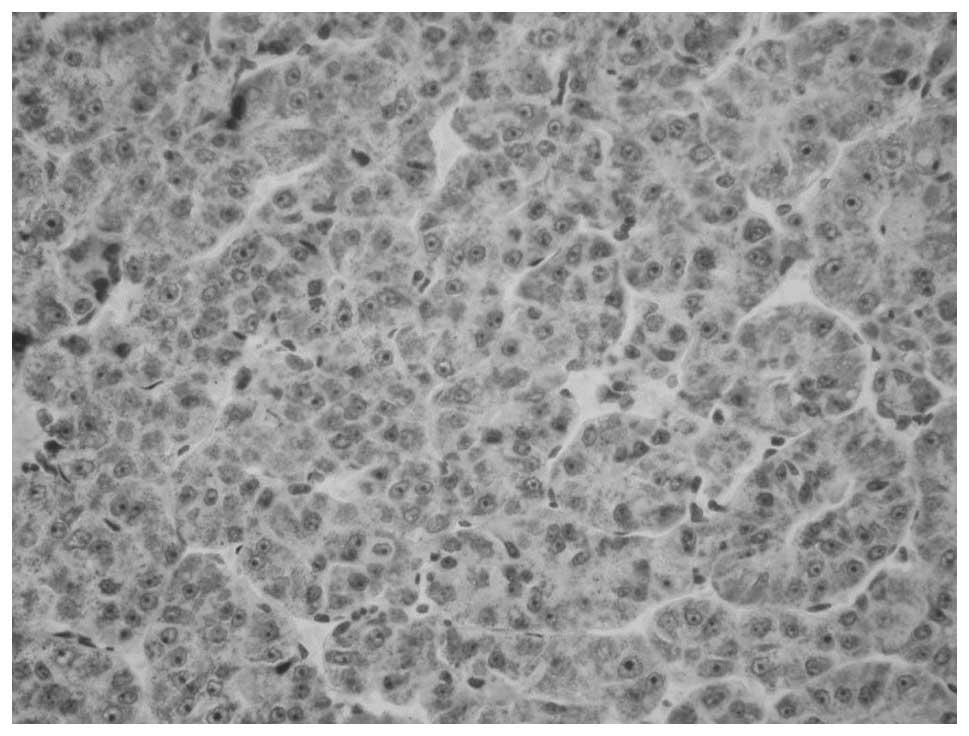|
1
|
El-Serag HB and Rudolph KL: Hepatocellular
carcinoma: epidemiology and molecular carcinogenesis.
Gastroenterology. 132:2557–2576. 2007. View Article : Google Scholar : PubMed/NCBI
|
|
2
|
Jemal A, Bray F, Center MM, et al: Global
cancer statistics. CA Cancer J Clin. 61:69–90. 2011. View Article : Google Scholar : PubMed/NCBI
|
|
3
|
Yu MW and Chen CJ: Elevated serum
testosterone levels and risk of hepatocellular carcinoma. Cancer
Res. 53:790–794. 1993.PubMed/NCBI
|
|
4
|
Yu MW, Cheng SW, Lin MW, et al:
Androgen-receptor gene CAG repeats, plasma testosterone levels, and
risk of hepatitis B-related hepatocellular carcinoma. J Natl Cancer
Inst. 92:2023–2028. 2000. View Article : Google Scholar : PubMed/NCBI
|
|
5
|
Lee CM, Lu SN, Changchien CS, et al: Age,
gender, and local geographic variations of viral etiology of
hepatocellular carcinoma in a hyperendemic area for hepatitis B
virus infection. Cancer. 86:1143–1150. 1999. View Article : Google Scholar : PubMed/NCBI
|
|
6
|
Hashemi M and Ghavami S: Hepatocellular
recurrence after orthotopic liver transplantation: Is combination
of α-fetoprotein and glypican-3 a reliable marker?: Hepatocellular
recurrence after orthotopic liver trasplantation. Hepat Mon.
11:155–156. 2011.PubMed/NCBI
|
|
7
|
Bruix J and Llovet JM: Major achievements
in hepatocellular carcinoma. Lancet. 373:614–616. 2009. View Article : Google Scholar : PubMed/NCBI
|
|
8
|
Parkin DM, Bray F, Ferlay J and Pisani P:
Global cancer statistics, 2002. CA Cancer J Clin. 55:74–108. 2005.
View Article : Google Scholar : PubMed/NCBI
|
|
9
|
Ma WL, Hsu CL, Wu MH, Wu CT, Wu CC, Lai
JJ, Jou YS, Chen CW, Yeh S and Chang C: Androgen receptor is a new
potential therapeutic target for the treatment of hepatocellular
carcinoma. Gastroenterology. 135:947–955. 2008. View Article : Google Scholar : PubMed/NCBI
|
|
10
|
Tavian D, De Petro G, Pitozzi A, et al:
Androgen receptor mRNA under-expression in poorly differentiated
human hepatocellular carcinoma. Histol Histopathol. 17:1113–1119.
2002.PubMed/NCBI
|
|
11
|
Feng H, Cheng AS, Tsang DP, et al: Cell
cycle-related kinase is a direct androgen receptor-regulated gene
that drives β-catenin/T cell factor-dependent hepatocarcinogenesis.
J Clin Invest. 121:3159–3175. 2011. View
Article : Google Scholar : PubMed/NCBI
|
|
12
|
Boonyaratanakornkit V and Edwards DP:
Receptor mechanisms mediating non-genomic actions of sex steroids.
Semin Reprod Med. 25:139–153. 2007. View Article : Google Scholar : PubMed/NCBI
|
|
13
|
Lelongt B, Trugnan G, Murphy G and Ronco
PM: Matrix metalloproteinases MMP2 and MMP9 are produced in early
stages of kidney morphogenesis but only MMP9 is required for renal
organogenesis in vitro. J Cell Biol. 136:1363–1373. 1997.
View Article : Google Scholar : PubMed/NCBI
|
|
14
|
Li J, Lau GK, Chen L, Dong SS, et al:
Interleukin 17A promotes hepatocellular carcinoma metastasis via
NF-kB induced matrix metalloproteinases 2 and 9 expression. PLoS
One. 6:e218162011. View Article : Google Scholar : PubMed/NCBI
|
|
15
|
Yang P, Yuan W, He J, Wang J, et al:
Overexpression of EphA2, MMP-9, and MVD-CD34 in hepatocellular
carcinoma. Implications for tumor progression and prognosis.
Hepatol Res. 39:1169–1177. 2009. View Article : Google Scholar : PubMed/NCBI
|
|
16
|
Kessenbrock K, Plaks V and Werb Z: Matrix
metalloproteinases: regulators of the tumor microenvironment. Cell.
141:52–67. 2010. View Article : Google Scholar : PubMed/NCBI
|











